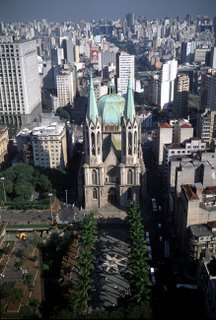Catedral da Sé

"We preached repentance to the crowds in front of the Sé Cathedral. There are a lot of people down there, it's crazy, everyone is walking rediculously fast and they all look late for something. It's almost impossible to make effective contacts. Pretty cool place, though."
The Catedral da Sé is the cathedral of São Paulo, Brazil. Its construction, in modified Gothic style, began in 1913 and did not end until four decades later. This delay was mainly a consequence of the use of granite in the greater part of its walls.
The cathedral (with the exception of its towers, which would be finished later) was dedicated in 1954 as part of the celebration of São Paulo's Fourth Centenary. It is the largest church in São Paulo, with a width of 11 meters, a length of 46 meters, towers 92 meters high, a dome 30 meters high, and capacity for 8,000 people. More than 800 tons of rare marble were used in its completion. The cathedral underwent a period of intense restoration between 2000 and 2002, and the São Paulo Department of Historical Property is in the process of obtaining legislative protection for it.
The cathedral's organ is the largest in Latin America, built in 1954 by the Italian firm of Balbiani & Rossi. It has five keyboards, 329 stops, 120 registers, and 12,000 pipes, the mouths of which display hand-engraved reliefs in the Gothic style.
In its crypt, which can be considered a subterranean church in its own right, are found works by the sculptor Francisco Leopoldo. Of special note is the bronze tomb of the cacique Tibiriçá, chief of the Guaianaz tribe, who welcomed the first Jesuits to the Piratininga Plateau and whose aid made the foundation of the city of São Paulo possible.


0 Comments:
Post a Comment
<< Home